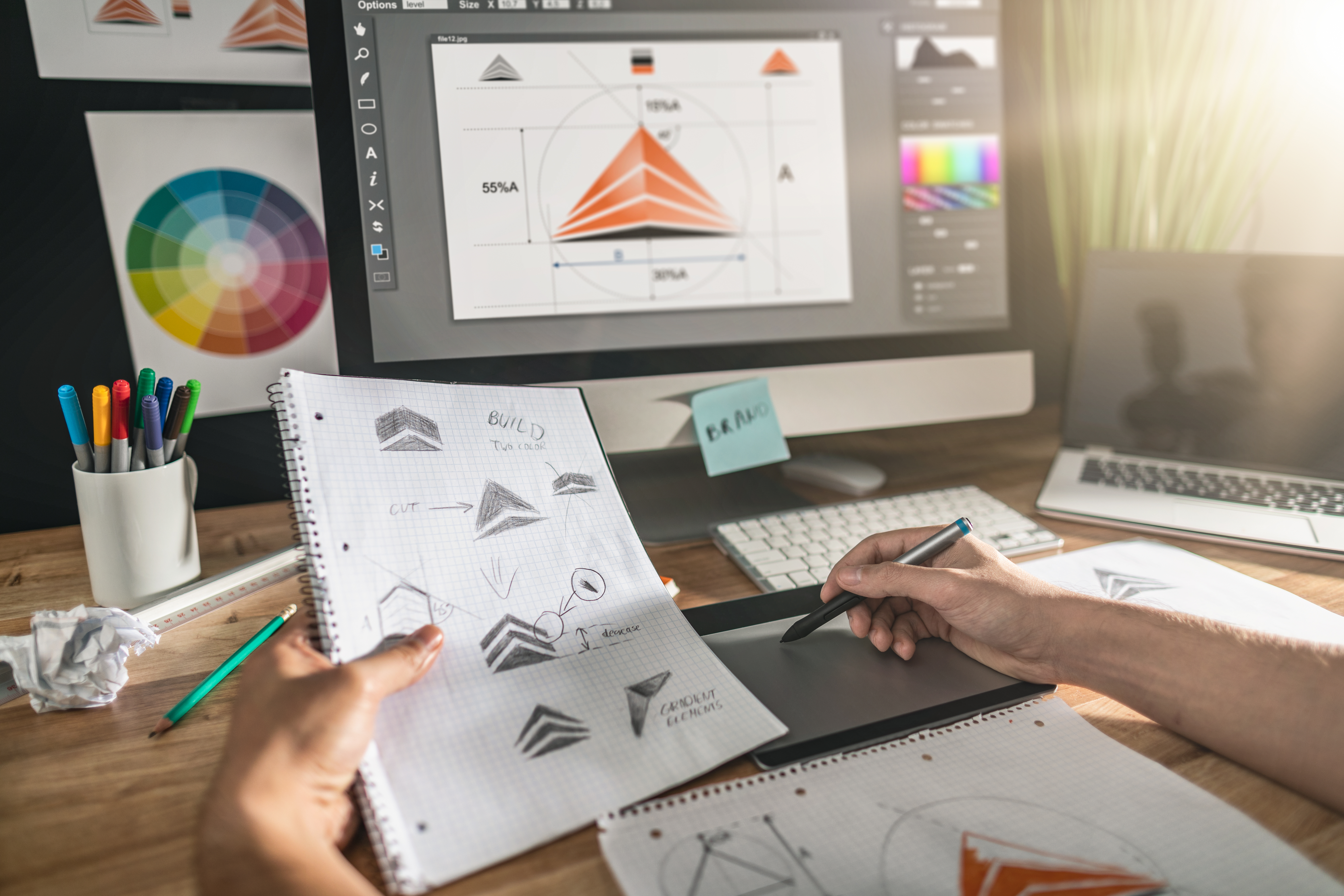Becoming a professional graphic designer calls for creativity, dedication, and a continuous zest for learning. If you're intrigued by the idea of communicating through visuals, allow us to guide you through the process.
Here's a comprehensive guide for aspiring designers wondering how to become a graphic designer. We'll explore the stepping stones to gaining the graphic designer qualifications that can pave your way to professionalism.
Jump to:
- What Qualifications Do You Need to Be a Graphic Designer?
- How Much Time Does It Take to Become a Professional Graphic Designer?
- Do You Need to go to University to be a Graphic Designer?
- How To Become a Graphic Designer: 9 Simple Steps
- Is Graphic Design a Good Career Choice?
- How To Become a Graphic Designer at Home
What Qualifications Do You Need to Be a Graphic Designer?
Regarding formal qualifications, many graphic designers hold a degree in graphic design or a related field. However, becoming a graphic designer is not solely anchored to formal education. An impressive portfolio can often outweigh educational credentials.
How Much Time Does It Take to Become a Professional Graphic Designer?
The time it takes to become a professional graphic designer can vary. If you choose to study at a university, earning a degree usually takes three to four years. Learning independently might take less time, but it depends on how quickly you learn and how much effort you put in. Becoming a professional is about more than just taking classes; it's a continuous process of learning and improving your skills.
Do You Need to go to University to be a Graphic Designer?
While a university degree can provide a comprehensive education and lend credibility in a competitive field, there are other routes to success. The digital era offers a wealth of resources—from online courses to tutorials—that enable aspiring designers to learn and grow. Dedication to your craft, a commitment to continuous learning, and practical experience can be just as valuable as formal education.

How To Become a Graphic Designer: 9 Simple Steps
Thinking about starting your career in graphic design? From mastering design fundamentals to building a standout portfolio, we've outlined a clear and engaging pathway for anyone ready to embark on this creatively fulfilling journey.
Step 1: Master the Core Principles of Graphic Design
To begin your career as a professional graphic designer, it helps to understand the basic principles. Begin by studying the core elements—line, shape, colour, space, texture, typography, and scale. These building blocks will form the basis of your design knowledge.
Learning how to use these elements effectively will enable you to create visually appealing and strategically effective designs. Explore resources such as design theory books, accredited online courses, and educational videos to deepen your understanding.
Step 2: Develop Your Unique Design Style
Your individuality is your trademark in the design world. Cultivate it by drawing inspiration from a variety of sources. Experiment with different styles, mediums, and techniques. Don't shy away from traditional art forms—they can provide a fresh perspective to your digital creations. As you develop your style, you'll see the world through a designer's lens, finding inspiration in the mundane and the magnificent.
Recommended for you!
Best SellersStep 3: Choose Your Educational Path Wisely
Deciding whether to go to school for graphic design or to teach yourself is a big decision. Going to school gives you a clear plan and a deep understanding of design, while teaching yourself lets you learn what you like at your own speed. Consider courses that offer a balanced approach—like those provided by Centre of Excellence—where you can learn how to become a graphic designer at home with the support and structure that mimics a traditional classroom.
Step 4: Master Key Graphic Design Tools
In the digital age, a graphic designer's toolbox is largely virtual. You need to understand how to use industry-standard software, including:
- Adobe Photoshop
- Adobe Illustrator
- Adobe InDesign
Mastery of these tools is essential, as they will serve as your canvas, brush, and palette. Take advantage of the online resources available to help you learn these tools, including video tutorials, forums, and practice exercises.
Step 5: Create a Compelling Portfolio
Your portfolio is a visual resume and often the first impression a potential client or employer has of your work. It should be a curated collection that displays your skills and tells your story as a designer.
Include a range of work demonstrating your versatility, problem-solving approach, and ability to meet clients' needs. Make sure your portfolio is accessible, well-organised, and updated regularly with your latest and greatest work.
Step 6: Work on Real Projects to Gain Experience
Theory and practice go hand in hand. Apply your skills to real-world projects to gain practical experience. This could be through internships, volunteering for non-profits, or taking on freelance work. Each project will teach you about client communication, time management, and the nature of the design process. The experience gained will be invaluable as you continue to grow professionally.
Step 7: Network with Other Designers and Creatives
Networking is key in the design community. Some effective ways to network include:
- Attending industry conferences
- Participating in design forums
- Engaging with other designers on social media
These connections can lead to mentorship opportunities, collaborations, and job offers. Remember, networking is a two-way street; be ready to give back to the community that supports you.

Step 8: Keep Up to Date with Design Trends and Techniques
Graphic design is an ever-evolving field. To stay relevant and innovative, you must be a lifelong learner. Follow design blogs, subscribe to trade magazines, and join webinars to keep up with the latest trends and techniques. Staying informed will ensure your designs remain fresh and competitive in a fast-paced industry.
Step 9: Establish Your Brand
As a graphic designer, you are your own brand. Create a strong online presence that reflects your professional identity. This includes having a professional website, active social media profiles, and a presence on design platforms like Behance or Dribbble. Your brand should communicate your unique style, professional values, and the quality of work you deliver.
Is Graphic Design a Good Career Choice?
A career in graphic design is not only about creating pleasing visuals; it's a pathway that offers many professional and personal rewards. Here's why many find it a fulfilling choice:
- Creative Expression. Graphic design is an outlet for imagination. Designers express their creativity daily, turning ideas into visual realities. This constant practice of creativity can lead to a deeply satisfying career for those passionate about art and design.
- Problem-Solving Challenges. Every design project is a problem or challenge that needs solving. Whether finding the best way to convey a message or making information accessible and attractive, graphic design is a puzzle that requires strategic thinking. This makes the job continuously engaging and intellectually stimulating.
- Versatility and Diversity. Graphic designers can work in many industries, such as advertising, publishing, web design, and more. Each sector offers unique challenges and the opportunity to work on diverse projects, from branding and packaging to digital interfaces and beyond.
- Impact and Influence. Designers have the power to influence behaviour and impact society. Good design can drive change, communicate important messages, and make information more digestible. Being at the helm of such influence can be incredibly rewarding.
- Continuous Learning. The design world is fast-paced and constantly evolving with new trends, tools, and technologies. This means there’s always something new to learn, keeping the career path fresh and exciting.
- Flexibility. Graphic design can offer a flexible working style. Many designers work freelance, set their own schedules, and even work remotely, which can lead to a more balanced lifestyle.
- Collaborative Environment. Designers often work with other creative professionals and clients from varied backgrounds, leading to enriching experiences and opportunities to learn from others.
- Entrepreneurial Opportunities. With skills in graphic design, you can start your own business, develop your brand, and work on projects you're truly passionate about. This entrepreneurial aspect can be highly rewarding for those with a business mindset.
- Recognition. Designers can gain recognition for their work. Whether through awards, publications, or social media, there is potential for public acknowledgement, which can be greatly fulfilling.
- Financial Potential. As designers grow in experience and reputation, they can command higher rates for their work. Successful graphic designers can achieve a lucrative career, especially if they can stand out in a competitive market.

How To Become a Graphic Designer at Home
With the rise of online learning platforms, it's possible to gain comprehensive knowledge and skills in graphic design from the comfort of your own home.
At Centre of Excellence, we offer a tailored Graphic Design Diploma Course that caters to individuals of all levels and experiences. Our course is designed to give you the foundational skills and techniques needed to thrive in the competitive world of graphic design. Follow the link and enrol for the discounted price of £29.
Take the first step towards becoming a professional graphic designer with us. Broaden your creativity, learn at your own pace, and build an outstanding portfolio. Your canvas awaits, and we're here to help you paint your success.













